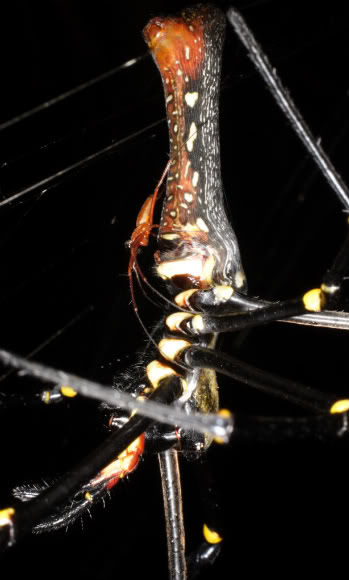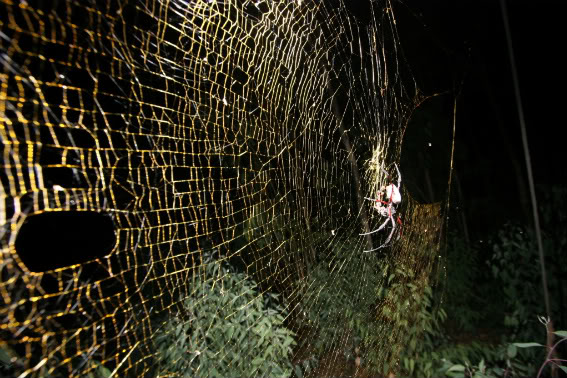Golden orb weaving spiders have been garnering media attention recently. Last year stunning photographs of a golden orb weaver eating a bird in Australia made world coverage. Now, over a century after the last legitimate species of golden orb weaver was discovered, researchers have announced the discovery of a new and rare species of golden orb weaving spider in Africa and on the island of Madagascar. On average the new species is the largest of all golden orb weavers known.
A specimen of the new spider, named Nephila komaci, was first found in 2000 in the Plant Protection Research Institute in Pretoria, South Africa. Matjaž Kuntner, chair of the Institute of Biology of the Slovenian Academy of Sciences and Arts and a Smithsonian research associate, made the discovery, calling it “surprising”.
 This photo shows extreme sexual size dimorphism in Nephila spiders: Small male on large female of Nephila pilipes in Singapore (not Nephila komaci). |
The lone specimen spurred Kuntner and colleagues to search throughout South Africa in hopes of finding the species. These expeditions found nothing. Then in 2003 a second specimen of the mystery arachnid was found in the Naturhistorisches Museum Wien in Vienna, Austria; this specimen had been collected in Madagascar—far from South Africa. However, since Kuntner and his team could not locate the species in the field or in any other museums they began to believe that the spider was extinct.
But then—eureka!—a colleague found a male and two females of the new species in Tembe Elephant Park in South Africa.
After publishing the find in PLoS ONE, Kuntner and his colleagues are now calling on the public to help find more populations of Nephila komaci in Africa and Madagascar.
“We fear the species might be endangered, as its only definite habitat is a sand forest in Tembe Elephant Park in KwaZulu-Natal,” said Jonathan Coddington, senior scientist and curator of arachnids and myriapods in the Department of Entomology at the Smithsonian’s National Museum of Natural History. “Our data suggest that the species is not abundant, its range is restricted and all known localities lie within two endangered biodiversity hotspots: Maputaland and Madagascar.”
Golden orb weavers are sexual dimorphic in size. While male spiders are regular-sized, females are evolutionary giants. The body-length of a female Nephila komaci can be as large as 1.5 inches (3.8 centimeters) with legs spanning 4-5 inches (10-12 centimeters). The golden orb weavers build the world’s largest webs: often spanning over a meter in size. Unlike other spiders, they build their nests to last—sometimes even several years.
In all more than 41,000 spiders are known to science. While an average of 400-500 new spider species are found every year, a new golden orb weaver has not been discovered since 1879.

This photo shows a giant golden orb-web exceeding 1 meter in diameter. The species is not Nephila komaci, but Nephila inaurata, Rodrigues, Indian Ocean. Photo by: M. Kuntner.
Related articles
Photos: Undocumented species discovered in Papua New Guinea

(03/25/2009) Colorful jumping spiders, a tiny frog with a “ringing song” and a striped gecko are among more than 50 previously unknown species discovered during a recent survey in the remote highlands of Papua New Guinea. More than 600 species were documented during the 2008 expedition, which was led by Conservation International (CI) under its Rapid Assessment Program (RAP).
Photos: Google Earth used to find new species

(12/22/2008) Scientists have used Google Earth to find a previously unknown trove of biological diversity in Mozambique, reports the Royal Botanic Gardens in Kew. Scouring satellite images via Google Earth for potential conservation sites at elevations of 1600 meters or more, Julian Bayliss a locally-based conservationist, in 2005 spotted a 7,000-hectare tract of forest on Mount Mabu. The scientifically unexplored forest had previously only been known to villagers. Subsequent expeditions in October and November this year turned up hundreds of species of plants and animals, including some that are new to science.
New bird species discovered in rainforest of Gabon
(08/23/2008) DNA analysis has revealed a previously unknown species of bird in the Central African country of Gabon.